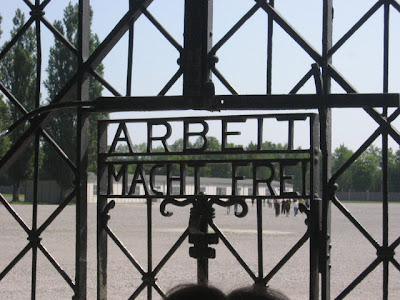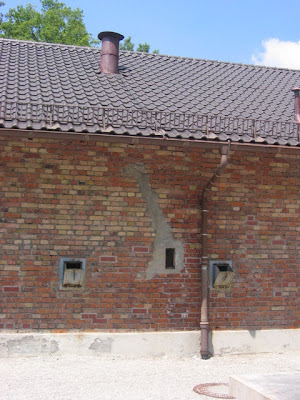As at several other camps, the entryway proclaims "Arbeit Macht Frei" -- "Work Makes Free" or "Labour produces liberty" -- an ironic slogan if there ever was one.

The barracks (a reconstruction) stand adjacent to the vast, empty plaza used for daily role calls. By the end of the war, each building (you see pretty much the whole thing here, and it's only one room "deep") housed 2000 prisoners.

Some plumbing fixtures from the original barracks survive. The bunks were rebuilt; these, built in a final iteration to increase capacity, were 3 or 4 layers high.



A few of the original guard towers remain. The fence was electrified -- "going to the fence" came to mean "committing suicide", a not uncommon occurrence among prisoners who lost the will to live -- and the grass section inside the fence was forbidden. Prisoners who "went to the fence" were often shot before they reached it; however, guards were instructed to maim rather than kill, so the prisoner could be caught alive and punished (often by being tortured to death) for attempting suicide.

Though many died here, Dachau was never a site of mass exterminations, at least not to the level that other camps were. Nevertheless, it did have its own small gas chambers. Each would hold up to 150 people. The chutes in the exterior walls were used to insert the gas canisters.
 From the inside, you can see the exterior light pouring into the niches were the gas cannisters landed.
From the inside, you can see the exterior light pouring into the niches were the gas cannisters landed.
One of the fixtures in this view of the opposite wall was a peephole where guards could check whether the gas had completed its deadly work. The ceiling fixtures are fake shower heads; prisoners were told they were going to be given a bath.

Adjacent to the gas chambers were the cremation ovens. Dachau started with two and had to build four more.

The ashes were scattered in the nearby grove, where a quiet pathway and meadow are now sacred to the memory of the "many thousands" whose earthly remains rest here.

When the Allies arrived at this site and "liberated" the camp, the horrified and disgusted American soldiers lined up a few of the guards and summarily executed them. These guards, however, were not the real criminals. The camp administration, staff, and guards had all fled, leaving in their place a few young and raw recruits who they had commanded to guard the prisoners.

What message should one take away from such a somber and depressing site? Why does it still exist?
I felt it was important to remember those who died there. So many who had the courage and strength to stand against wrong, to proclaim a different view from those in power; so many who didn't fit a prescribed mould, being gypsy (Roma), Jewish, Jehovah's Witness, homosexual, or otherwise "degenerate" in the eyes of those in power; so many who unknowingly and unintentionally incited the fear or envy of those in power -- they had hopes and dreams and lives ruthlessly crushed and scattered in this place. They should not be forgotten. But for the random fact of being born in our time, place, or nation, we might have been them.
Nor should those who developed and ran this camp, and all the others like it, be forgotten. "Brutal, sadistic, abusive" -- these adjectives apply to them. But so do the adjectives "disciplined, organized, dedicated, thorough, clean, obedient". But for the random fact of being born in our time, place, or nation, we might have been them, too.
I included (above) the anecdote describing the execution of the innocent guards by enraged American soldiers to remind myself that we are all capable of atrocity. What about the American fire-bombing of Dresden or Tokyo, or their atrocities in the Philippine colony? Dachau was the first German concentration camp, true, but the prize for inventing concentration camps goes to the British (during the Boer War in South Africa).
There is, it would seem, a demon in each of us. Every day, by our thoughts, choices, and actions, we are either strengthening that demon, or we are crucifying it. War does not create angels or demons, heroes or cowards; it only makes the ones that already present in us more apparent.
Who can say where he would have stood, what he would have done, had fate placed him in Germany during Hitler's rise to power?

This question was brought home to us again during a subsequent "Third Reich Tour" of Munich. This is Robert, our tour guide (American) and a Ph.D. candidate in history at University of Munich, holding forth as he stands in downtown Munich beside Herr Wolf's favorite place to meditate, read, and plan. ("Herr Wolf" was Hitler's preferred alias.)
 Robert detailed Hitler and the Nazi's rise to power. Though we often forget it, both got their start in Munich. Hitler only went to Berlin after he became Germany's Chancellor, and even then, he often returned to his power base in Munich. Thirty minutes walk around Munich allows one to visit his favorite beer garden, the site of the "Beer Hall Putsch", his favorite fountain (above), the Nazi Party headquarters, and similar locales.
Robert detailed Hitler and the Nazi's rise to power. Though we often forget it, both got their start in Munich. Hitler only went to Berlin after he became Germany's Chancellor, and even then, he often returned to his power base in Munich. Thirty minutes walk around Munich allows one to visit his favorite beer garden, the site of the "Beer Hall Putsch", his favorite fountain (above), the Nazi Party headquarters, and similar locales. Robert described the events immediately following WWI that virtually set us up for WWII. (Above is a WWI memorial.) He covered the period from about 1920-1933 when we should have known what Hitler was all about, when his own people could have stopped him. By the time the Nazis were elected to power in 1930 and then Hitler was named Chancellor in 1933, his opponents were being quietly ushered off to jail and/or killed, their families and friends terrorized, and only massive civil disobedience might have prevented WWII ... if that.
Robert described the events immediately following WWI that virtually set us up for WWII. (Above is a WWI memorial.) He covered the period from about 1920-1933 when we should have known what Hitler was all about, when his own people could have stopped him. By the time the Nazis were elected to power in 1930 and then Hitler was named Chancellor in 1933, his opponents were being quietly ushered off to jail and/or killed, their families and friends terrorized, and only massive civil disobedience might have prevented WWII ... if that.While Munich still holds many places central to this history, there are few memorials. This downtown structure memorializes those who died under the Reich, but it is hidden by trees from the roadway, and it would be hard to tell what it is all about without walking up close enough to read the engraving.
 The Nazi's Party headquarters was destroyed and lay barren and overgrown until the descriptive signboard (lower right) was placed quite recently.
The Nazi's Party headquarters was destroyed and lay barren and overgrown until the descriptive signboard (lower right) was placed quite recently. Some of the locals must remember, though. We were told that, when a large rock concert was held in the nearby green space some years ago, Munich residents were alarmed by the tourists who climbed these mounds for a better view, and told them they must come down and not tread there.
Some of the locals must remember, though. We were told that, when a large rock concert was held in the nearby green space some years ago, Munich residents were alarmed by the tourists who climbed these mounds for a better view, and told them they must come down and not tread there.Robert also told us about going to see a neo-Nazi rally and demonstration downtown. He was alarmed to find himself pushing through thousands of demonstrators ... until he found that these several thousand, forcibly corralled and held back by the police, were all demostrating against the fifty or so neo-Nazi demonstrators.
The building were Hitler met with Disraeli is now a music conservatory. Perhaps that is fitting.

And the Bavarian "capitol" building was reconstructed, after the war, with two enormous glass wings -- symbolizing that the operations and works of government must ever be transparent, open to public scrutiny and correction.
 All-in-all, the tours were a window not so much into the German soul, as into the human soul. And perhaps it's just as well to have a lot of windows for scrutiny and correction there, too, eh?
All-in-all, the tours were a window not so much into the German soul, as into the human soul. And perhaps it's just as well to have a lot of windows for scrutiny and correction there, too, eh?
No comments:
Post a Comment